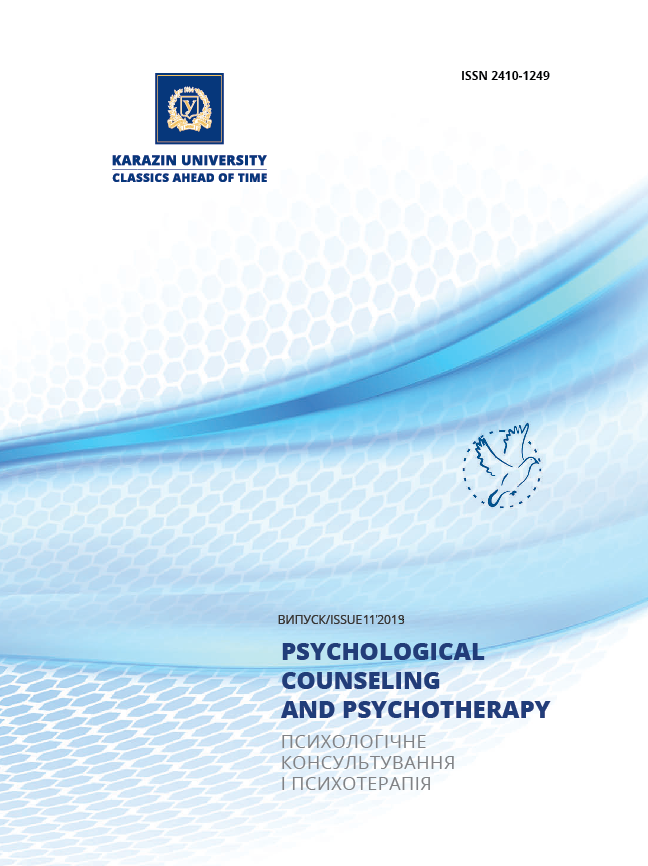Expiriental Grounds of Classification and Psychotherapy of the Personality Development Problems
Abstract
The problems of classification of psychological problems, which are particularly acute in the period of rejection of nosological (etiopathogenetic) grounds: normalization of pathological manifestations and tolerance to them are the essence of the cultural mainstream. Given the approach to etiopathogenic classification built on experiential grounds. Four classification axes are considered. The first axis of classification is the types of emotional schemes that are formed in ontogenesis early enough. The scheme includes five components: the actual primary "blocking" experience, the corresponding system of early memories, bodily manifestations (emotions-in-body), corresponding cognitive representations (interpretations) of situation and motivation. In the literature there are attempts at the classification of such schemes, which are called "early non-adaptive schemes" (John Young), however, in this version of the classification confused primary and secondary "blocking" experiences and they are not tied to certain ontogenetic periods and psychotrauma. Therefore, the classification of emotional schemes needs further elaboration. The second axis of classification is the type of personal process, which is determined by the structure of the organization of the psyche. Type of personal process, and they are four (optimal, fragile, dissociative and psychotic), determines the ability of the client to move in psychotherapy. The third axis of classification is the type of organism flow and the level of its actualization. K. Rogers has left the list organismic tendencies. The fourth axis of the classification – the degree of acceptance of the personality of the body flow, that is the depth of self-actualization.
Downloads
References
Achenbach, Thomas M., Ndetei, David M. (2018). Клинические модели поведенческих, эмоциональных и социальных проблем у детей и подростков. В Joseph M. Rey (ред.). Руководство по детской и подростковой психиатрии: в 2 т. (Т. 1, с. 86-103). Киев: Горобец.
Общественная ризома. Беседа с Александром Дьяковым. Электронный ресурс: https://www.vshm.science/blog/avkurpatov/921
Уніфікований клінічний протокол первинної, вторинної (спеціалізованої) та третинної (високоспеціалізованої) медичної допомоги «Гендерна дисфорія». Наказ МОЗ України № 972 від 15.09.2016.
Hart, J. (1970). The development of client-centered therapy. In J. Hart, T. Tomlinson (eds.). New Development in client-centered therapy (pp. 3-22). Boston: Houghton-Mifflin.
Greenberg, L., Safran, J. (1989). Emotion in Psychotherapy. American Psychologist, Vol. 44, No. I, 19-29.
Main, M. (1991). Metacognitive knowledge, metacognitive monitoring, and singular (coherent) vs multiple (incoherent) models of attachment. In C.M. Parkes, J.S. Hinde and D. Marris (eds.). Attachment Across the Life Cycle. (pp. 127-159.). London: Travistock/Routlege.
МакДугалл, Дж. (2007). Театры тела. Психоаналитический подход к лечению психосоматических расстройств. Москва: Когито-Центр.
Ницшке, Б. (1998). Значение сексуальности в трудах Зигмунда Фрейда. В Б. Ницшке (ред.). Энциклопедия глубинной психологии. З. Фрейд. Жизнь, работа, наследие (Т. 1., с. 365–406.). Москва: Издательство: Interna, Менеджмент.
Андрющенко, Т.Г. (2001). Истома любви. Харьков: ООО «Модель Вселенной», 2001.
Бондаренко, О.Р (2012). Этиология психических нарушений в клиент-центрированной терапии. Журнал практического психолога, 1. 102 – 119.
Галимзянова, М.Ф., Касьяник, П.М., Романова, Е.В. (2016). Выраженность ранних дезадаптивных схем и режимов функционирования схем у мужчин и женщин в период ранней, средней и поздней взрослости. Вестник СПбГУ, 16 (3), 109 – 125.
Кочарян, А.С. (2018). Протекание процесса в клиент-центрированной психотерапии. Психологічне консультування і психотерапія. Харківський національний університет імені В.Н. Каразіна, 9, 16-22.
Mearns, D., Thorne B. (2008). Person-centred counselling in action. London: Sage.
Warner, M.S. (2013). Person-centred therapy at the difficult edge: a developmentally based model of fragile and dissociated process. In D. Mearns and B. Thorne (eds.) Person-centred therapy today (pp. 144-171). London: Sage.








